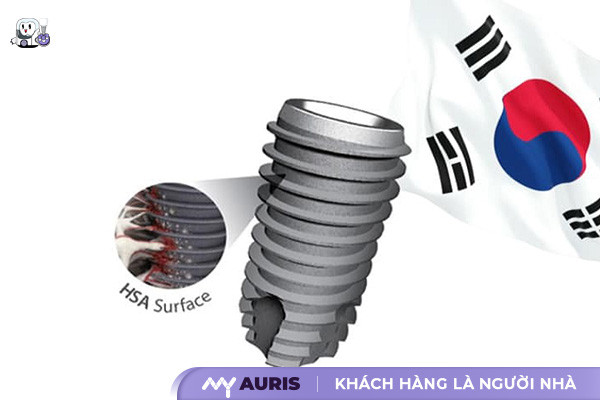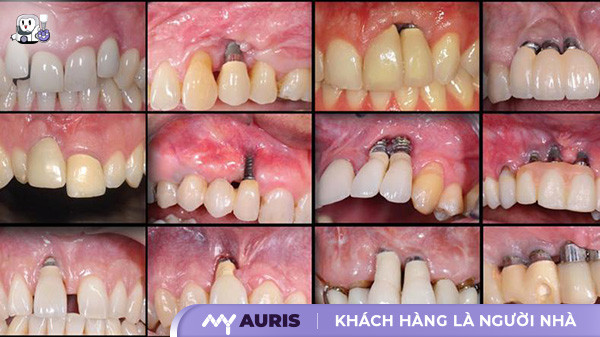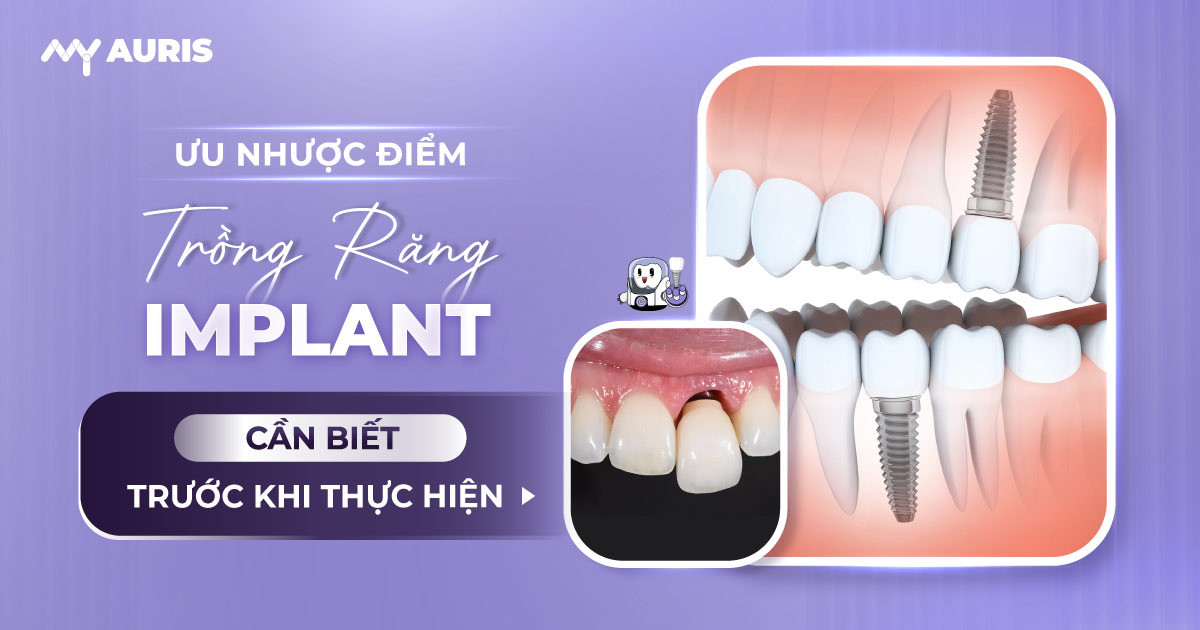To restore confidence for those with missing teeth and make eating more convenient, choosing dental implant placement is an optimal solution that should be considered. Implants are not only an advanced dental method but are also highly valued by many experts for their durability and aesthetic appeal. However, patients need to be aware of the potential disadvantages of dental implant placement if they do not choose a reputable dental facility that ensures service quality and the dentist’s skill. This helps patients minimize risks, protect long-term oral health, and optimize treatment effectiveness.
Outstanding Benefits of Dental Implant Placement
Dental implant placement is the most modern tooth restoration method available today, with a structure similar to natural teeth in both appearance and function. A dental implant consists of three parts: the implant post (acting as the tooth root), the abutment connector, and the porcelain crown that restores the tooth body. After the implant post is surgically placed into the jawbone, the dentist will wait 2 – 6 months for the post to integrate stably with the bone before attaching the porcelain crown, completing the new tooth.
This method is suitable for:
- People missing 1 tooth in any position, such as incisors, canines, or molars
- People missing multiple adjacent teeth or teeth in different positions
- People missing all teeth in the upper or lower jaw
Outstanding Advantages of Dental Implant Placement:
Effectively Prevents Jawbone Resorption
Jawbone resorption is an inevitable consequence if teeth are lost for an extended period without treatment. When an implant post is placed into the jawbone, the titanium material will bio-integrate with the bone, stimulating bone growth and preventing tooth shifting, gum recession, and malocclusion. This is a unique feature that other methods like dental bridges or removable dentures cannot achieve.

Maximum Preservation of Natural Teeth, No Tooth Grinding Required
A significant advantage of dental implants is their independent existence, not relying on adjacent teeth. Unlike porcelain bridges (which require grinding down two natural teeth to serve as abutments) or removable dentures (which have clasps that can harm adjacent teeth), implants are placed directly into the missing tooth space, comprehensively preserving natural teeth and avoiding impact on the remaining teeth.
Safe Titanium Material, Permanent Lifespan
The implant post is crafted from pure titanium – a biocompatible material that has been proven to be well-tolerated and capable of rapid integration with bone. If properly cared for, implants can last permanently, ensuring patients don’t have to worry about replacing their teeth in the future.
Perfect Chewing Function Restoration, High Aesthetics
Thanks to their strong integration with the jawbone, dental implants allow patients to chew comfortably, just like with natural teeth. Not only durable, but implants also offer high aesthetics with colors and shapes similar to natural teeth. Furthermore, dental implants support clear pronunciation, reducing the lisping often caused by missing teeth.
First Disadvantage of the Dental Implant Placement Method
Although highly regarded for its durability and aesthetics, the dental implant placement method still has some disadvantages that individuals with missing teeth should be aware of before choosing this treatment.
Not Suitable for All Individuals
Not everyone can undergo dental implant placement, especially individuals under 16 years old. At this age, the jawbone is still developing, so if performed too early, the risk of implant burial will be very high, leading to low treatment efficacy.
Therefore, anyone interested in dental implant placement should proactively undergo a general examination and consult a specialist to clearly determine the health status of their jawbone and teeth. For cases that do not meet the conditions or are in a bone development phase, the doctor will propose a more suitable treatment method to ensure long-term safety and effectiveness.

Highly Qualified Doctors Required
Dental implant placement is a complex restoration technique that requires dentists to have high professional qualifications, extensive clinical experience, and a deep understanding of the jawbone. According to industry regulations, only dentists who have graduated and have a minimum of 1.5 years of professional practice are qualified to perform implant placement. Therefore, when choosing a dental clinic, patients need to thoroughly research information and avoid randomly selecting an unreliable address. The evaluation of a dentist’s competence must be based on various factors such as treatment records, customer feedback, and supporting equipment, to ensure the implant procedure achieves maximum effectiveness and safety.
Dental Implant Placement Not Recommended for Children Under 16
For children under 16 years old, dental implant placement is not yet recommended because the jawbone at this age is still in the process of development. If performed too early, the risk of implant burial due to continued bone growth is very high. Additionally, low bone density in adolescents makes it difficult for the implant post to firmly integrate with the bone. However, the age of 16 is only a relative reference point, as each individual has a different rate of jawbone development. The dentist needs to conduct a detailed assessment using X-rays, CT scans, and clinical examinations to determine the appropriate timing, ensuring the safety and effectiveness of the restoration.

High Cost of Dental Implant Placement
Compared to the average income of Vietnamese people, the cost of dental implant placement is still quite high, typically ranging from 13 million to 38 million VND, depending on the type of implant and supplementary techniques such as bone grafting, sinus lift, or accompanying dental aesthetics. This is a significant investment but ensures long-term restoration effectiveness, minimizes implant complications, and increases implant lifespan if performed with the correct technique at a reputable implant dental clinic.
Extended Implant Treatment Duration
The implant placement method often requires a relatively long treatment period, potentially up to 6 months. Although immediate implant placement techniques are now available to shorten treatment time, they are only suitable for carefully selected patients. Compared to other tooth replacement methods, implant placement involves a more complex procedure, requiring multiple appointments and careful implant care to limit complications.
Implant Restorations are More Prone to Food Trapping than Natural Teeth
Prosthetic teeth on implants often tend to trap food slightly more than natural teeth, but this is a common phenomenon. To avoid discomfort and prevent implant complications, users need to practice proper oral hygiene, especially adept use of dental floss. Cleaning after each meal will help extend the implant’s lifespan and keep the implant area clean and healthy.
Implant Lifespan Depends on Dentist’s Skill and Quality of the Implant Dental Clinic
Implants can last a long time, even a lifetime, if properly cared for and performed at a reputable implant dental clinic. However, implants can also fail prematurely due to various reasons such as loose screws, chipped porcelain crowns, or other implant complications. When these issues occur, patients need to quickly visit a dentist for examination and timely correction of implant errors to protect the effectiveness of the dental implant restoration and prevent severe complications. In cases of implant failure (implant coming loose), it may be necessary to perform another implant placement or switch to a different suitable restoration option.

Complications When Choosing Unreliable Dental Clinics for Dental Implant Placement
When undergoing dental implant placement at unreputable dental clinics, patients may encounter several serious dental implant complications. These include prolonged bleeding and swelling after surgery, often stemming from damage to thin bone tissue or infection caused by inaccurate wound closure techniques. Additionally, inflammation and swelling around the implant post, if not addressed promptly, can lead to bone loss around the implant site, directly affecting jaw health.
Another common cause is a tilted or misaligned implant post, often due to incorrect surgical technique or improper implant placement, which severely impacts aesthetics and chewing function. Furthermore, the use of inadequate imaging technology, lacking modern Cone Beam – CT scans, can lead to inaccurate treatment planning, increasing the risk of failure during the implantation process.
Although these complications can occur, the actual rate of complications is quite low if patients choose a reputable clinic with an experienced team of dental professionals and standard procedures. With outstanding implant placement advantages such as natural aesthetic restoration and effective chewing function, this method is still considered the top choice for individuals with missing teeth.





